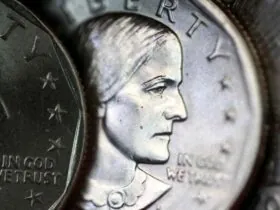Do you have a 1974 quarter and wonder how much it could be worth if you decided to sell it? Or are you thinking of adding this coin to your collection?
Whether you’re looking to buy or sell, understanding its market value is crucial. This guide will help you explore the 1974 quarter’s value, features, and tips for grading your coin. You’ll also discover valuable error coins to watch for. By the end, you’ll have a clear idea of how much a 1974 Washington quarter might fetch in today’s market.
Let’s dive in!
1974 Quarter Value Chart
This Article Includes
| Mint Mark | Good | Fine | Extremely Fine | Uncirculated |
| 1974 No Mint Mark | $0.30 | $0.30 | $0.30 | $1 |
| 1974 D Quarter | $0.30 | $0.30 | $0.30 | $1 |
| 1974 S (Proof) | – | – | – | $2 |
| 1974 S (Proof Cameo) | – | – | – | – |
| 1974 S (Proof Deep Cameo) | – | – | – | $4 |
History of the 1974 Quarter
The 1974 quarter belongs to the Washington quarter series, first minted in 1932 to honor the bicentennial of President George Washington’s birth.
The U.S. Mint introduced the Washington quarter to replace the Standing Liberty quarter. The coin’s design was based on a bust of Washington created by French sculptor Jean-Antoine Houdon. Initially, Laura Gardin Fraser won a design competition for this coin, but Treasury Secretary Andrew Mellon selected John Flanagan’s design instead.
Production began in 1932, and the coin was released into circulation by August of that year. The design remained largely unchanged until 1965, when the Coinage Act eliminated silver content in U.S. coins due to a severe shortage caused by hoarding. From then on, quarters were struck with a copper core and copper-nickel cladding.
Features of the 1974 Quarter
Obverse
The obverse features George Washington’s left-facing bust, modeled after Houdon’s sculpture. “LIBERTY” is inscribed at the top, with “IN GOD WE TRUST” on the left and the date, 1974, at the bottom. Flanagan’s initials, “JF,” appear near Washington’s collarbone.
Reverse
The reverse depicts an American bald eagle perched on a bundle of arrows, symbolizing strength and independence, framed by olive branches representing peace. The inscriptions include “UNITED STATES OF AMERICA” at the top, “E PLURIBUS UNUM” above the eagle, and “QUARTER DOLLAR” at the bottom.
Specifications
- Composition: Copper core with 75% copper and 25% nickel cladding
- Weight: 5.67 grams
- Diameter: 24.30 mm
- Edge: Reeded
- Mint Marks: No mint mark (Philadelphia), “D” (Denver), “S” (San Francisco proofs)
Grading the 1974 Quarter
When grading, focus on the coin’s high points:
- Obverse: Cheekbone, jawline, area around the ear
- Reverse: Eagle’s chest, wing tips, and legs
A coin qualifies for mint state designation if its luster, details, and rim are intact. Below are the standard grades:
| Grade | Description |
| 1-3 | Basal State, Fair |
| 4-6 | Good |
| 12-15 | Fine |
| 20-30 | Very Fine |
| 40 | Extremely Fine |
| 50 | About Uncirculated |
| 60-70 | Mint State |
1974 Quarter Value Guides
The U.S. Mint produced approximately 1.57 billion quarters in 1974, making them widely available and affordable. Here’s a breakdown of their value:
1974 No Mint Mark Quarter

Philadelphia struck 801,456,000 quarters without a mint mark. Circulated examples are worth about $0.30, while uncirculated coins can reach $260 in MS67 grade. A rare MS67+ sold for $2,115 in 2020.
1974 D Quarter

The Denver Mint produced 353,160,300 quarters. Circulated coins range from $0.30 to $0.85, while gem-quality examples in MS67 can sell for $1,450.
1974 S Quarter (Proof)

San Francisco struck 2,612,568 proofs. Regular proofs are worth $15, with cameo and deep cameo varieties fetching higher prices. Rare PF70 examples can command up to $10,925.
Rare 1974 Quarter Errors
Some 1974 quarters with minting errors can fetch significant premiums:
- Clipped Planchet Error: Worth up to $200.
- Off-Center Strike Error: Can bring in $150 or more, depending on the percentage of misalignment.
Where to Sell Your 1974 Quarter
If you’re ready to sell, there are many platforms available. Research options to find the best fit for your needs, considering pros and cons like fees and audience reach.
Also Read:
THIS IS ONLY A BLOG POST FOR INFORMATION – WE DO NOT BUY, SELL, OR APPRAISE THESE ITEMS







Leave a Reply